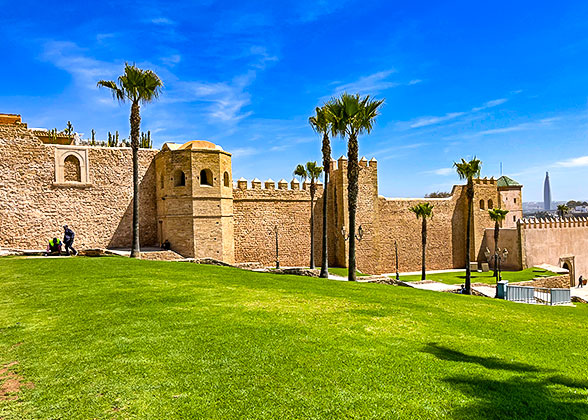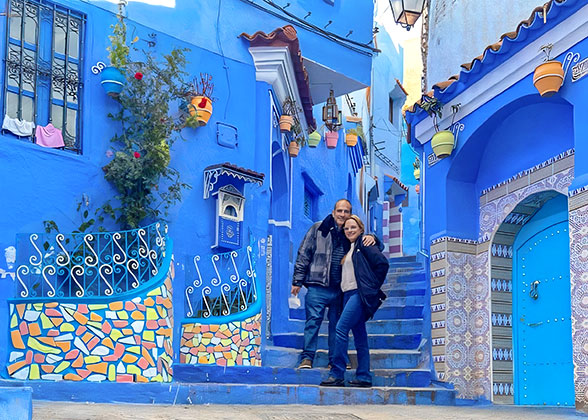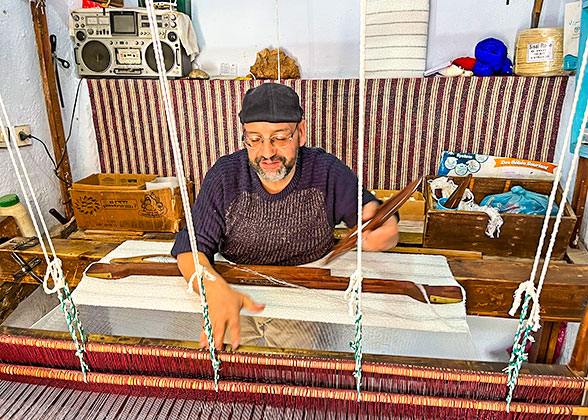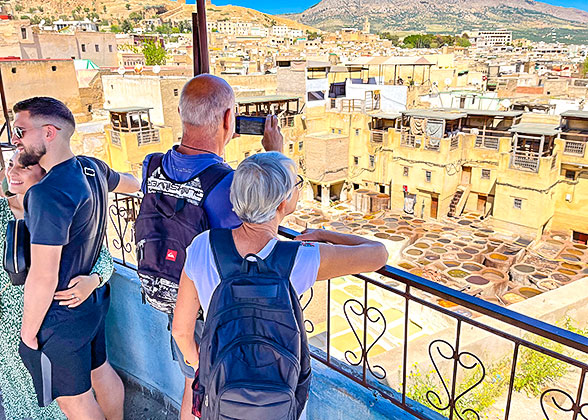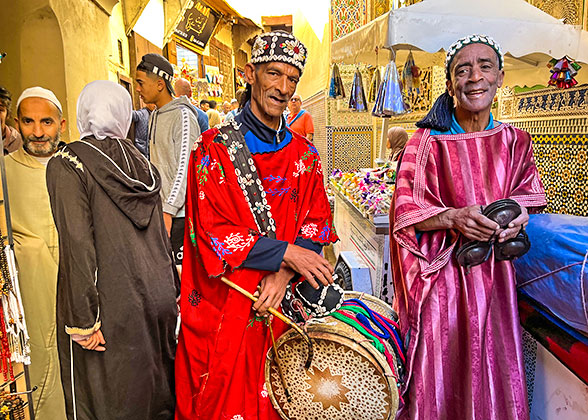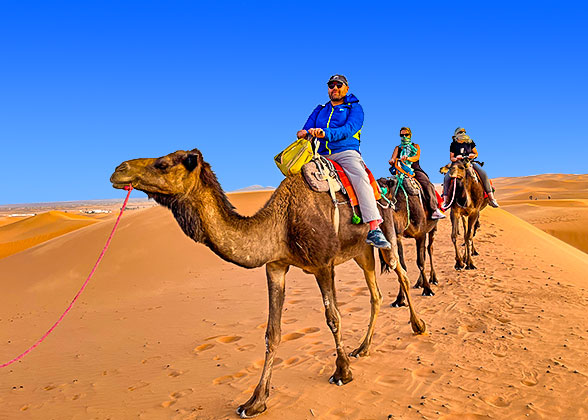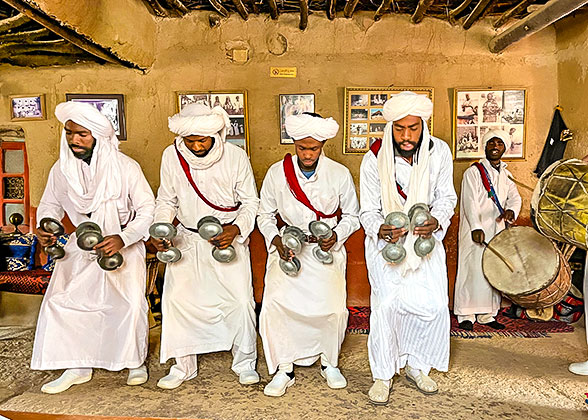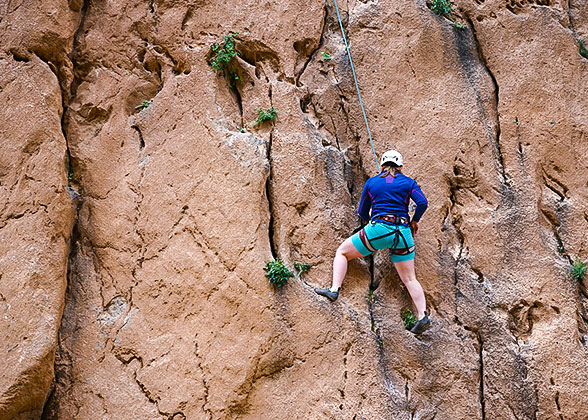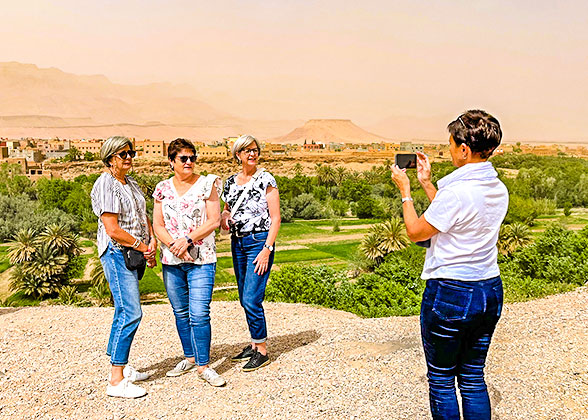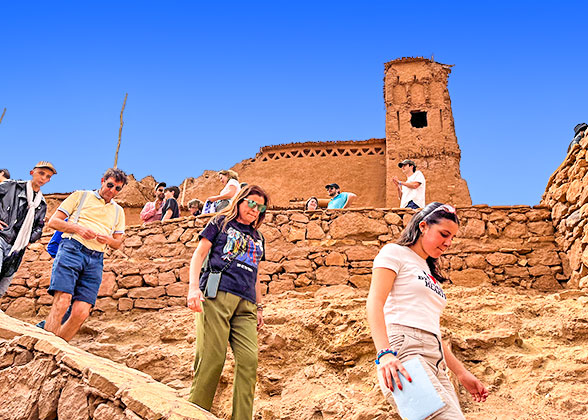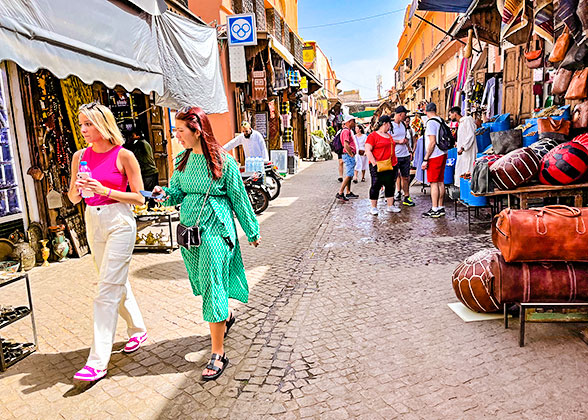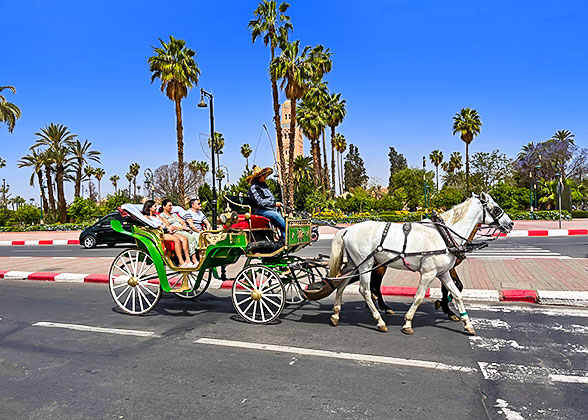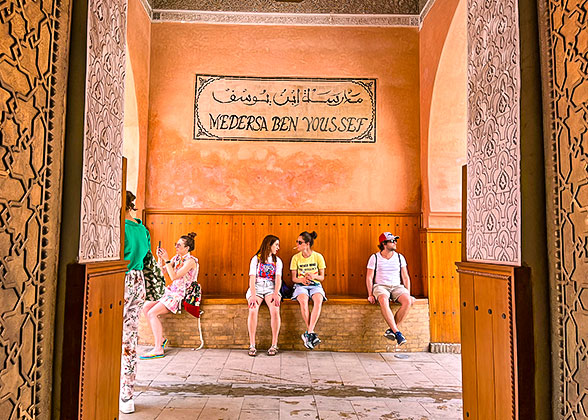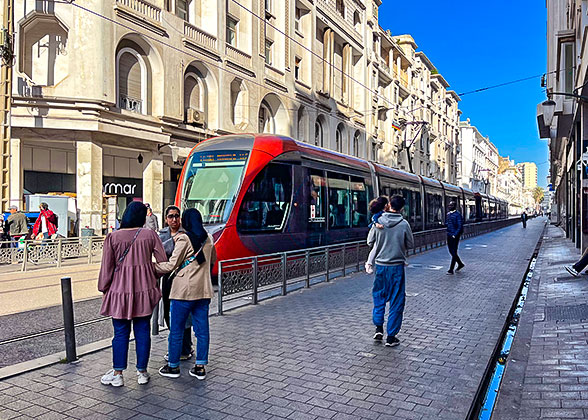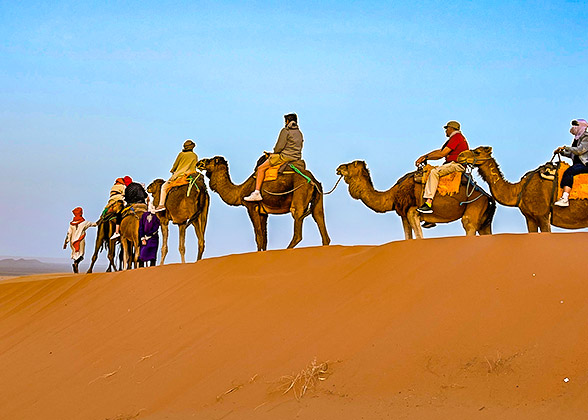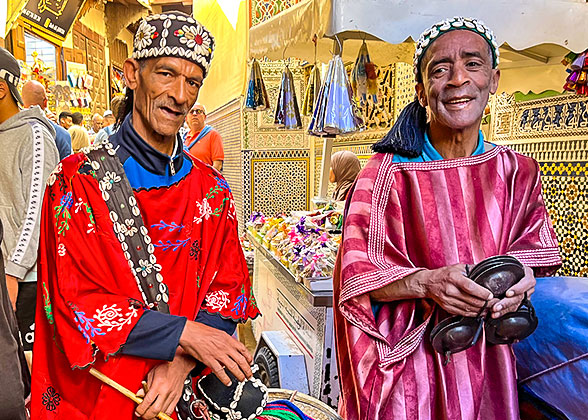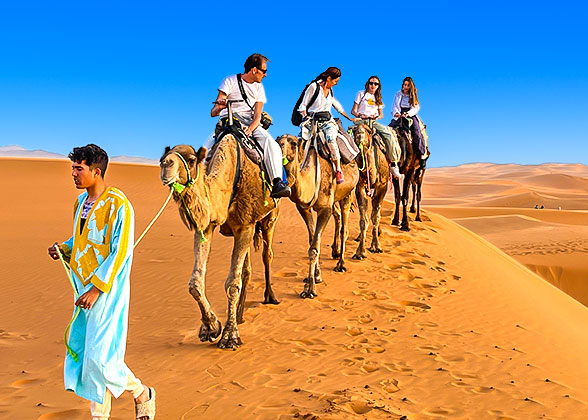Day 1: Arrival in Casablanca, Airport Pick-up; Drive to Rabat; Explore Rabat
When your flight lands in the Mohammed V International Airport in Casablanca, the driver guide will pick you up and transfer you to Rabat, the capital city. Upon arrival, he/she will help you check-in at the hotel. Your driver guide will lead you to explore this ancient imperial city, including Mausoleum of Mohammed V, the Hassan Tower which is adjacent to the mausoleum, and Kasbah of the Udayas, to appreciate the ancient fortresses in white and blue. ★ Privilege of Our Guests:The observation platform of Kasbah of the Udayas is the highest point of the entire fortress. In ancient times, guards stood guard here day and night, looking out at the Atlantic Ocean, and could find out any enemy attack the first time if there was. Today, it is still the best vantage point for overlooking the whole city of Rabat. It's worth mentioning that this is also the shooting location of the movie Mission: Impossible 5, where Tom Cruise drove his motorcycle from the castle straight into the Atlantic... At the open-air café in the castle, we will serve you a cup of classic Moroccan coffee or hot mint tea with some pieces of "ghriba", a traditional almond cookie. Kasbah of the Udayas Hassan Tower
|
Day 02: Rabat to Tangier via Asilah; Visit Spartel Cape, Hercules Cave & Tomb of Ibn Battouta
This morning, we'll head to Asilah, a tranquil coastal town on the Atlantic Coast. It will take about 2.5 hours by car. This beautiful town is known for its tall ochre walls, white houses, and the cleanest Medina in Morocco. In summer, there are also Art and Cultural Festivals, on which you would feel the enthusiasm and vitality of the town. For lunch, the Spanish seafood paella here is worth a try. The meal is at your own expense. After lunch, we will continue a 40-minute drive to Tangier, the northernmost city in this country. Upon arrival, we will pay a visit to the Spartel Cape. As the northwest corner of the African continent, it offers a splendid view of the Atlantic Ocean and Mediterranean Sea. Later, we’re going to tour the Hercules Cave, whose shape resembles the map of Africa. Behold, the nature, a great artist, has not forgotten to mark Madagascar Island on this map! Thereafter, we’ll proceed to the Old Medina of Tangier and Kasbah Museum to observe the local life. Then, you’ll be escorted to the Tomb of Ibn Battouta, and round out today's Morocco desert trips at the Grand Socco, a bustling market, where you may get some handcrafts as your souvenirs. Meals: Breakfast
|
Day 3: Tangier to Chefchaouen; Visit Tetouan En route; Explore Chefchaouen
Chefchaouen Medina After breakfast, we’ll drive to Tetouan in about one hour. It is one of the nine UNESCO World Heritage Sites in Morocco, offering a unique blend of Arabic and Spanish cultures. Then, we will go to Chefchaouen, a fairytale mountain city with blue dwellings in every corner. There have been many versions as to why Chefchaouen was painted blue. Some say it is because the blue Ras El Maa Spring is the main water source for the town, and people paint their houses blue to symbolize the water of life being filled the town. It is also said that it is to anti-mosquito, as the natural pigment called Tekhelel has a good anti-mosquito function, and would appear varying shades of blue depending on its concentrations. Moreover, there is also another saying involving religion. Blue represents the sky and heaven in Judaism, and Jews believe that they would be protected by God if they paint things blue. Thus, they painted buildings blue with the migration of Jews... Upon arrival, you will check in your hotel and have lunch on your own. In the afternoon, you will firstly visit the Outa-el-Hamman. Then, we’ll continue our tour to Kasbah Museum and the cobblestone medina, which is home to Jewish settlers. Next is the Grand Mosque, whose octagonal minaret is well known. The last stop is the Spanish Mosque on a hill, which offer the perfect place to overlook Chefchaouen. After the guided tour, the rest of the day is free for you to visit this touristic area at leisure and take some pictures. Meals: Breakfast
|
Day 4: Chefchaouen to Fez; Visit Ruins of Volubilis, Moulay Idriss & Meknes on the Way
After breakfast, we will transfer to Fez. The whole journey is 211 kilometers (131 miles), taking about 4 hours by car.
En route, we will visit the ruins of the Volubilis, an ancient Roman city from where grain and olive oil were exported to Roman Empire. To give you a clearer perception of the best-preserved Roman site in Morocco, we will arrange a professional guide for you on this fully explained trip. The whole visit will take about 2 hours.
Afterward, we will continue to the holy town of Moulay Idriss, which occupies a special place in the hearts of Moroccans. Then we’ll drive to Meknes, once served as the capital city of Morocco and dubbed as one of the four imperial cities. A 2-hour walking tour in Meknes will take you to the Bab Mansour Gate, El Hedim Square, Dar Jamai Museum, Mausoleum of Moulay Ismail and the Royal Stables, which also has huge granary to store grain and grass used for royal horses.
Then, we will go on to Fez. Upon arrival, check in at your hotel and have a good rest overnight.
Meals: Breakfast
|
Day 5: Fez: Visit Old Medina, Tanneries, University of Al Quaraouiyine & Mausoleum of Moulay Idriss II
Bronze Wares in Fez Medina Today's tour starts with the Fez Medina, where you may easily get lost in the delightful maze of narrow lanes; thus, a professional local guide will be arranged to show you around Fez Medina. In the ancient town of Fez, it is like walking into the book of The Thousand and One Nights. The maze of narrow alleys are distributed with a variety of shops, in addition to restaurants, butcher shops, green groceries, mostly of which are handicrafts shops of copper, silver, lamps, potteries, carpets and more. All the handicrafts are all handmade in ancient ways, as the jingling has never stopped for more than 1,000 years. Of course, the most memorable site should be the Chouara Tannery, the only major tannery in Morocco that still keeps traditional leather dyeing. The tanners endure the acrid smell as well as the acid-base corrosions of excrement and lime water, and make the first-class leathers by millennia-old process. Maybe you do not know, the raw materials of luxury brands such as Chanel and Louis Vuitton are purchased here. Later, you will be guided to the world's oldest existing university, University of Al Quaraouiyine. Next, move towards the El-Attarine, which is decorated by magnificent zellige and exquisite carved patterns. Later, visit the Bou Inania Medersas, the first college to spread Islam and the only one with a mosque in Fez, and the Mausoleum of Moulay Idriss II. When night comes, it's recommended to enjoy a traditional Hammam for relax at your own. Meals: Breakfast Tanneries, Fez Morocco People
|
Day 6: Fez to Merzouga via Ifrane, Ziz Gorge, Erfoud; Sahara Desert Camp
Today is a long driving day for about 7-hour drive. On the way, we will pass through a clean and green town of Ifrane, well known as its nickname "a Little Switzerland" of the Atlas Mountains. Then, continue our way through the Atlas Mountains, drive along the Ziz Gorge, and enjoy its spectacular view with its palm groves. We’ll head up to dunes of Erg Chebbi at Merzouga via a beautiful small town of Erfoud.
On arrival in Merzouga, we will meet our camel guide, one-hour camel riding will take you into the desert and watch stunning sunset. You will return to the camp on the camel. Dinner is arranged in the camp and followed by a small bonfire party with drum music.
Meals: Breakfast, Dinner
|
Day 7: Explore Sahara: Khamlia, Nomad Village and Erg Chebbi
Early in the morning, your camel guide will take you to see the most memorable sunrise of your life, and then return to the camp for a shower. After breakfast in the camp, you will start your morning adventure of the desert by a 4X4 vehicle. The first stop is an abandoned mine that used to be very busy during the French colonial era. Next, visit the Village of Khamlia and listen to their Gnawa music. Although their instruments are only drums and some simple wooden and iron tools, they can play checkered beautiful music. Currently, about 250-300 Gnawa people live here, all descended from slaves from Central Africa, with dark skin and large bright eyes. We will meet the nomad families, explore their way of life and try the traditional Berber Pizza with a cup of tea. Finally, we will stop over at a nomadic market, where the items sold are totally handmade products from local nomadic hordes. Finally, we’ll drive back and enjoy lunch in the camp. The rest of the day is your leisure time. Dinner will be served in the camp. Meals: Breakfast, Lunch, Dinner
|
Day 8: Merzouga to Dades Valley via Todra Gorge
You have another chance to see sunrise over the desert this morning. After breakfast, we will drive to Todra, about 200 kilometers (124 miles) and taking a 3-hour drive. Todra Gorge features 300 meters (984 feet) high cliffs on the two sides with a clear creek in the middle. It is the highest and narrowest gorge in Morocco.
★ One-Hour Hiking Tour with Home-cooked Lunch
Lunch will be arranged at a family-run restaurant, where you will not only taste the most authentic Moroccan food, but also have the opportunity to visit the host’s home and chat with the host. After lunch, there will be a 1-hour hiking in and around Todra Gorge. You will enjoy the stunning scenery, and also encounter the goatherd and his goats, donkeys carrying loads and local farmers working nearby. This is completely a good opportunity to get to know the real life in Morocco.
Next, we will continue our journey to another beautiful gorge, the Dades Gorge with red cliffs and the zigzagging mountain roads, taking about an hour by drive. Upon arrival, you will be escorted to take a walk around the valley.
Meals: Breakfast, Lunch
|
Day 9: Dades Valley to Ouarzazate via Rose Valley and Skoura Oasis
After breakfast, we will travel through the Dades Valley to Skoura Oasis, a journey of 80 kilometers (50 miles), taking 1.5 hours or so. This stretch is a part of the famous Road of A Thousand Kasbahs, as Kasbahs in various scales are scattered across villages, hillsides, and oases. Some are well preserved, but others are in ruins now. If needed, we will stop at any time for you to take photos. About 20 minutes from Dades Valley, Rose Valley, also known as Kalaa Mgouna, is our first stop. We come here for only one reason – roses. In April every year, there is a sea of roses, and pink Damask roses would adorn the corners of the whole town. If you visit in early May, there is a chance to experience the annual rose festival. Most tourists come here to buy rose water (rose essential oil), which is quite precious as usually a small bottle of rose water needs several tons of rose petals to make. Here's a tip: Although rose water is made from pink roses, pure rose water is often colorless or slightly pink. It is 50 kilometers (31 miles) from Rose Valley to Skoura Oasis which would take about 1 hour by car. ★ Activities in Skoura Oasis1. You will be guided to visit the Kasbah Ameridil, the best preserved Kasbah in the region. 2. A one-hour hiking or biking tour in Skoura Palmeraie is included. If you want to try a donkey ride, the extra charge could be paid on site. Continuing 1 hour drive, we will reach the destination Ouarzazate today and check into the local hotel. Meals: Breakfast
|
Day 10: Visit Atlas Studio, Ait Ben Haddou & Telouet Kasbah; Transfer to Marrakech
After a big breakfast, you will be guided to visit Atlas Corporation Studio and the Ksar of Ait Ben Haddou, a UNESCO World Heritage site. The earthen clay walls and houses make the village unique, because many Hollywood movies have been shot here, making it have become one of the representative complexes of North Africa. On the way, we would have seen a lot of Ksars and Kasbahs, and you may wonder how to tell them apart. In fact, there is no strict difference between them, as both belong to the local defensive fortifications. A Ksar usually refers to a defensive village, while a Kasbah is more likely a fortress to protect a powerful family. Thereafter, we’ll proceed to the Telouet Kasbah, famous for the oldest Islamic architecture. Then, we will drive to Marrakech over the Tizi n’Tichka Pass and the high Atlas Mountains, and stay overnight there.
Meals: Breakfast
Ait Ben Haddou Medina of Marrakech
|
Day 11: Marrakech: Explore Berber Culture in Imlil Village by Trekking
At 9:00 am, you will be escorted to the Ourika Valley at the foot of the Atlas Mountain. It takes about 1 hour by car. First of all, we will arrange a 1-hour camel ride tour for you to enjoy the wonderful scenery, meanwhile to have a deeper understanding of the real historical development of the Berber villages. Next, we will continue to drive for about 1.5 hours to Imlil village, a small village located at the foot of Jebel Toubkal, the highest peak of Atlas Mountain, attracting visitors from the world with numerous hiking routes.
Lunch is arranged in a traditional Berber home where you will sit down to enjoy mint tea made by the hostess and the most traditional local dishes. You can experience the lifestyle of the aboriginal people of North Africa, and get an opportunity to learn how to make tea in the optimal traditional way.
After lunch, a 1-2 hours’ trekking tour can be arranged for you depending on your needs. Meanwhile, the mules are await you to embark your trek through the fine views of the mountains. The trek would end at a small waterfall, where you can take a rest by the cool water. At the end of the tour, we’ll drive back to Marrakech.
★ Tour Highlights
● 1-hour Camel Ride in Ourika Valley.
● Family-cooked lunch with hand-made Mint Tea.
● Mountain Trek with mules and a local guide.
Meals: Breakfast, Lunch
|
Day 12: Marrakech: Visit Koutoubia Mosque, Bahia Palace, Saadian Tombs & Jemaa el-Fna Sqaure
Bahia Palace, Marrakech After breakfast, a professional local guide will pick you up at the hotel and arrange a carriage ride to the Old Medina, which is about 20 minutes away. The first stop today is the Koutoubia Mosque, a fragrant mosque in the city center, and the high minaret of this mosque can be seen from anywhere in the old medina of Marrakech. Then, we will proceed to the Bahia Palace built at the end of the 19th century. Exquisite mosaics, high tall arches, rare stones, fountains and gardens can be seen everywhere inside the elegant palace. Thereafter, we’re to visit the Saadian Tombs to appreciate the valueless artistic form of the buildings. Next, you’ll be guided to the Koranic School - Ben Yousself Medersa. At the end of the day, spend some free time exploring the fabulous Jemaa el-Fna Square. After that, we will return to the hotel by carriage. ★ Privilege of Our Guests:• Travel between the hotel and Old Medina by horse-drawn carriage instead of regular vehicle. • A professional local guide will accompany you throughout the Old Medina. Apart from learning more about the history and culture of this ancient city, you would also be shown around to discover yummy local snacks hidden in the alleys. Meals: Breakfast
|
Day 13: Marrakech: Visit Jardin Majorelle & YSL Museum; Transfer to Essaouira
After breakfast, we will start the journey to Jardin Majorelle and the nearby Yves Saint Laurent Museum. Then, transfer to Essaouira in a 2.5 hours' drive. As the famous Wind City in Africa, the seaside city Essaouira is endowed with wind from the Atlantic Ocean all year round, making it an ideal place to go surfing or sailing. At first glance, you may be attracted by the golden sand beaches and crystal blue sea. There are several small ports from which locals may go fishing on the sea. Please cast your eyes on the shore wall, and you will see remains of the ancient forts, which indicates how powerful the fortification was during the Portuguese colonial period. Meals: Breakfast Horse-Drawn Carriage Medersa Ben Yousself
|
Day 14: Enjoy your Free Time in Essaouira
Today is free for you to explore this coastal city. If you are eager to witness local people's lifestyle, it's advisable to visit the old medina of Essaouira, where you may see the ancient turrets. Otherwise, you can take a leisurely walk along the seashore to feel the gentle ocean breeze.
► Things to do in Essaouira:
● The windy city of Essaouira is prefect for surfing, wind surfing and kite-surfing.
● In the evening, it will be an unforgettable experience to watch the sunset while riding on a horse at Safi Beach.
● A seafood meal can’t be missed in Essaouira. If getting up early enough, you can also go to the local port to buy the freshest seafood from the fishermen. Any seafood restaurant will be glad to process for you with charging a reasonable fee.
● Try a traditional Hammam or a Berber massage to make your Morocco tour more perfect.
Meals: Breakfast
|
Day 15: Essaouira to Casablanca; Visit King Hassan II Mosque & Jewish Historical Museum
After breakfast, the drive to Casablanca will take about 4.5 hours. On the way, there is also a chance to witness the unique spectacle of Morocco – goats up to the trees. ★ Tour Highlight – Goats In the TreesIn this barren land, goats have practiced the trick of climbing trees and eating leaves for survival! Of course, some people doubt that this scene is man-made. Perhaps, the "goats in trees" that we can see anywhere on the roadside is indeed suspicious. However, we must admit that deep in the desert, there is really a herd of goats climbing the tall tree just for a leaf. It’s all to survive! When arriving in the seaside city Casablanca, we’ll continue to the King Hassan II Mosque, the 3rd largest mosque in the world. This mosque is not only appreciated for its exquisite exterior appearance, but also known for being built on a promontory over the sea. Thereafter, proceed to the Jewish Historical Museum of Morocco, which offers a good opportunity to learn about the Jewish history and culture. Meals: Breakfast Hassan II Mosque Street Scene of Morocco
|
Day 16: Departure from Casablanca; See off
After breakfast, you will be transferred to the airport for your return flight, which indicates that your Morocco desert tour has come to the end. We sincerely wish you a pleasant journey with us!
Meals: Breakfast
|

